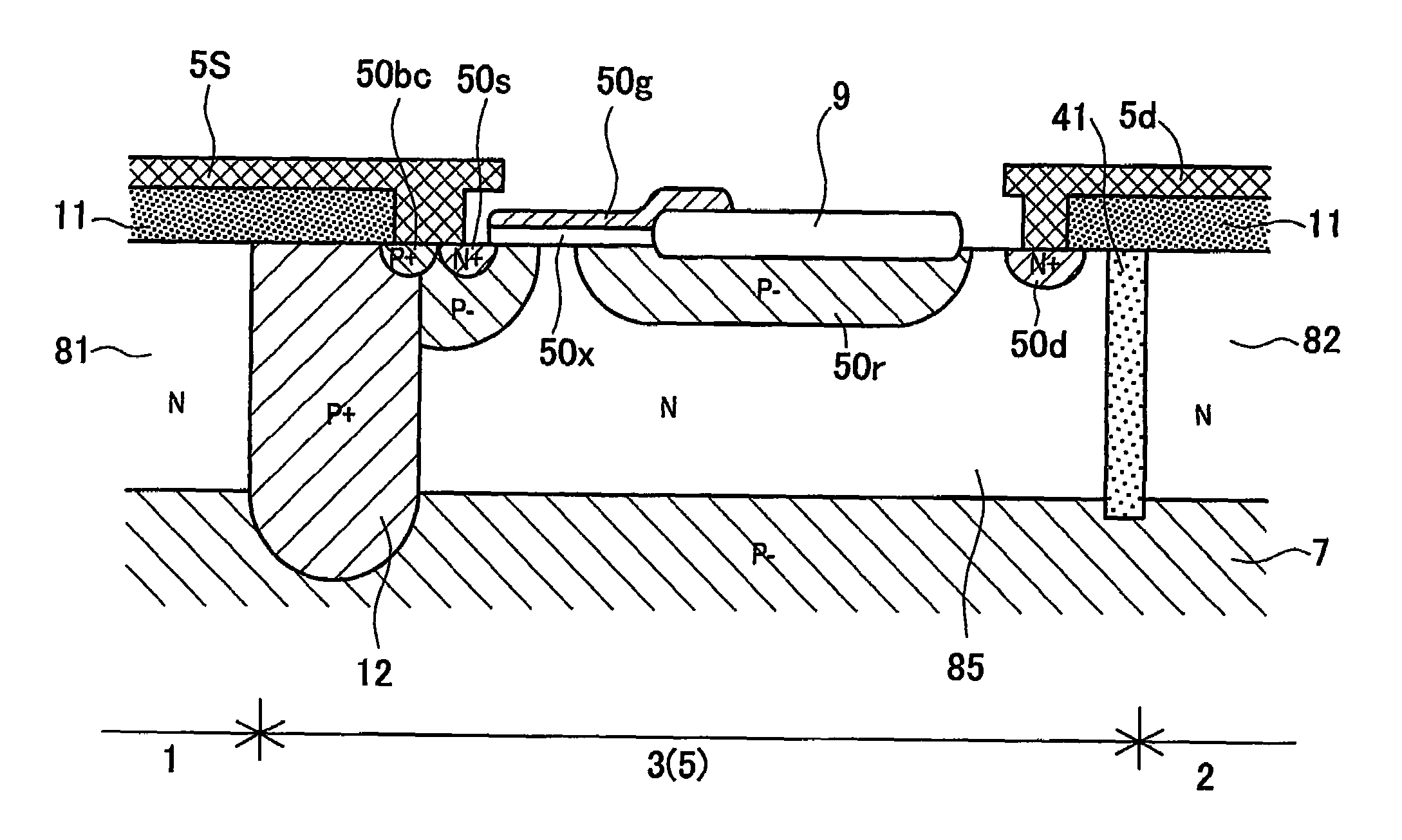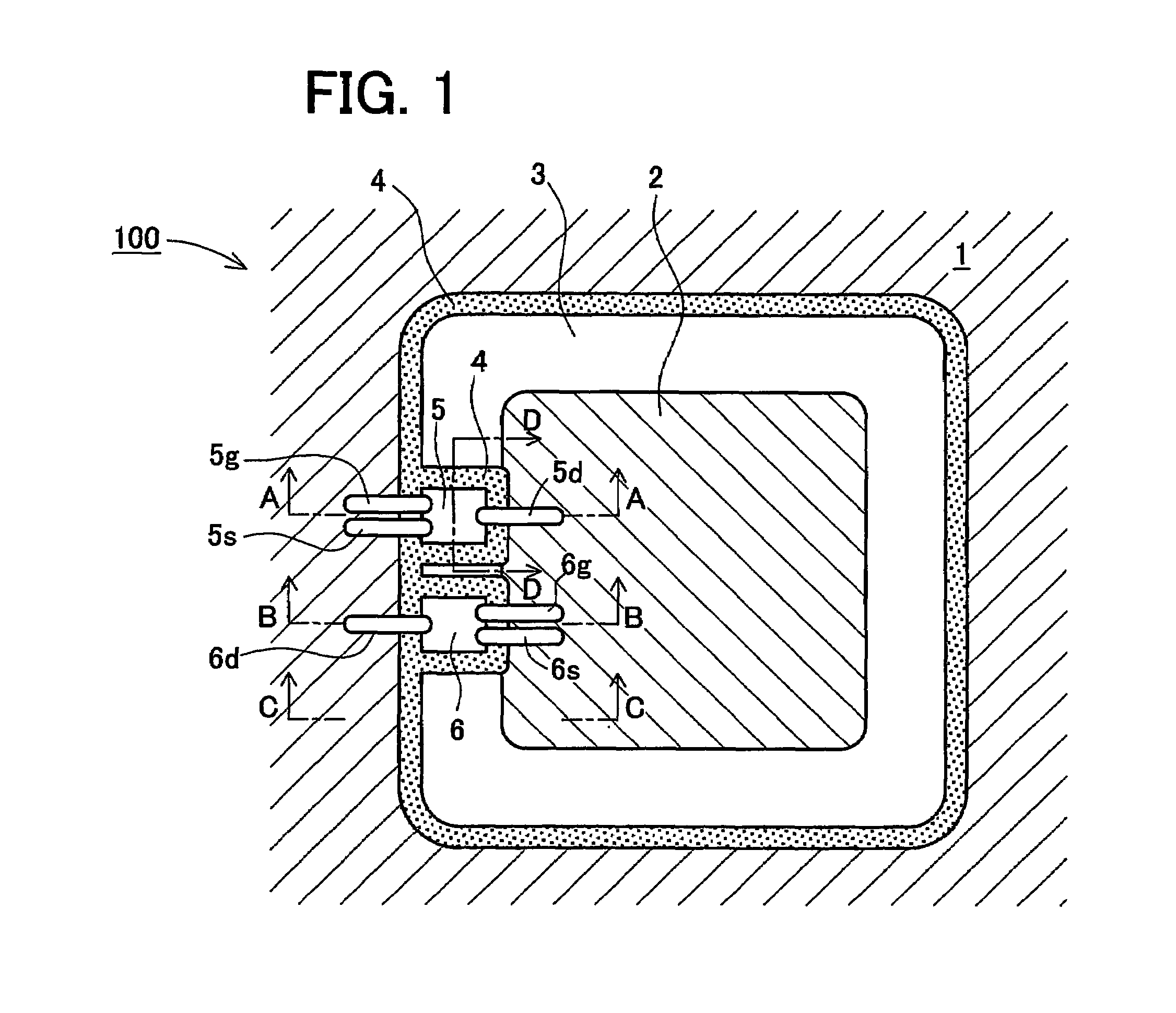Semiconductor apparatus
a semiconductor and apparatus technology, applied in the field of semiconductor apparatuses, can solve the problems of reducing the withstand-ability against voltage, complication of wiring process, and semiconductor apparatuses in the above-reference documents, and achieve the effects of preventing leakage current, high withstand voltage separating region, and easy modification of design
- Summary
- Abstract
- Description
- Claims
- Application Information
AI Technical Summary
Benefits of technology
Problems solved by technology
Method used
Image
Examples
first exemplary embodiment
[0046]A semiconductor apparatus 100 in a first exemplary embodiment has a structure as shown in a plan view in FIG. 1. Same reference numerals as the components of the conventional semiconductor apparatus shown in FIG. 16 represent identical functions. The semiconductor apparatus 100 comprises a low potential reference circuit region 1 and a high potential reference circuit region 2, and the high potential reference circuit region 2 is surrounded by a high withstand voltage separating region 3, which is known as resurf structure. By this high withstand voltage separating region 3, the low potential reference circuit region 1 and high potential reference circuit region 2 are separated from each other. Further, a trench 4 is formed at the outer periphery of the high withstand voltage separating region 3. The trench 4 is filled up with insulating material such as silicon oxide. Accordingly, the high potential reference circuit region 2 is isolated from the low potential reference circu...
second exemplary embodiment
[0056]A semiconductor apparatus 200 in a second exemplary embodiment has a structure as shown in a plan view in FIG. 6. The semiconductor apparatus 200 comprises a low potential reference circuit region 1 and a high potential reference circuit region 2, and the high potential reference circuit region 2 is surrounded by a high withstand voltage separating region 3 same as in the semiconductor apparatus 100 in the first exemplary embodiment. Further, trenches 41, 42 are formed in part of the high withstand voltage separating region 3, and the high withstand voltage separating region 3 is partitioned into plural regions. A high withstand voltage NMOS 5 and high withstand voltage PMOS 6 are provided in the partitioned areas. What differs from the semiconductor apparatus 100 in the first exemplary embodiment is that the trenches 41, 42 do not surround completely high withstand voltage NMOS 5 and high withstand voltage PMOS 6, respectively. More specifically, trenches are not formed at th...
third exemplary embodiment
[0058]A semiconductor apparatus 300 in a third exemplary embodiment has a structure as shown in a plan view in FIG. 8. The semiconductor apparatus 300 comprises a low potential reference circuit region 1 and a high potential reference circuit region 2, and the high potential reference circuit region 2 is surrounded by a high withstand voltage separating region 3 same as in the semiconductor apparatus 100 in the first exemplary embodiment. Further, a high withstand voltage NMOS 5 is provided in part of the high withstand voltage separating region 3. An outer wall trench 43 and an inner wall trench 44 are also provided. The semiconductor apparatus 300 of this embodiment, unlike the semiconductor apparatus 100 in the first exemplary embodiment, does not have trench for partitioning the high withstand voltage separating region 3. It is hence effective to prevent lowering of withstand voltage due to crystal defects or the like likely to occur near the trench.
[0059]Only for the purpose of...
PUM
 Login to View More
Login to View More Abstract
Description
Claims
Application Information
 Login to View More
Login to View More - R&D
- Intellectual Property
- Life Sciences
- Materials
- Tech Scout
- Unparalleled Data Quality
- Higher Quality Content
- 60% Fewer Hallucinations
Browse by: Latest US Patents, China's latest patents, Technical Efficacy Thesaurus, Application Domain, Technology Topic, Popular Technical Reports.
© 2025 PatSnap. All rights reserved.Legal|Privacy policy|Modern Slavery Act Transparency Statement|Sitemap|About US| Contact US: help@patsnap.com



